In the springtime, mama and papa birds busily collect materials to build their nests. Different bird species will use all sorts of materials to construct a well-supported and often cushioned place for their eggs and future young. Kids and grown-ups can easily gather materials to help out parent birds, setting them out in homemade or purchased containers. What a fun project!
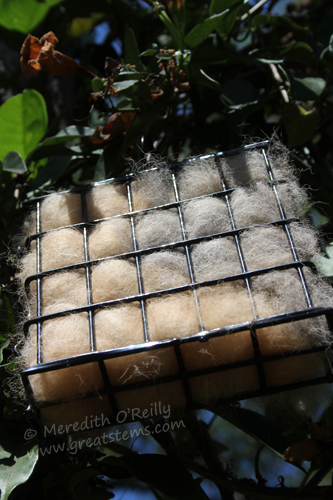
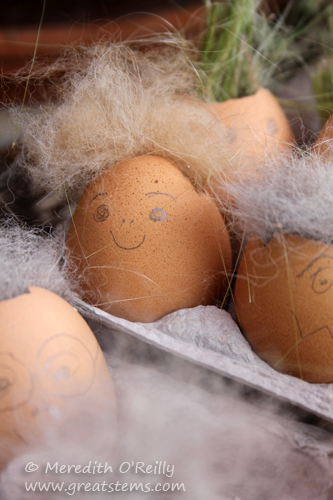
Dog fur is one of my favorite materials to use, perhaps because at my house it’s so readily available (and the dogs are content to share, as they enjoy getting brushed). But I love the fact that Titmice and other birds will sometimes steal clumps of fur directly off sleeping dogs outside — it certainly makes a nice soft lining for nests. Be sure you haven’t used flea treatments on your pets if using this material for nesting options.
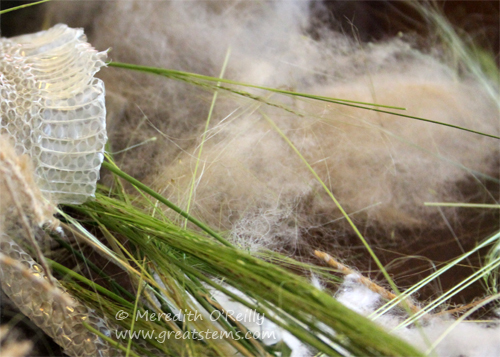
When gathering materials, remember that natural is best, of course. Consider the following:
- Dog fur (free of flea treatments; cat or rabbit fur works, too)
- Dry grasses (free of pesticides or herbicides)
- Hay or straw
- Real cotton fiber
- Feathers
- Tiny twigs
- Leaves
- Pine needles
- Sheep’s wool
- Plant fluff and seeds
- Snake skin (if you have pet snakes, for example)
- Coconut fiber
Note: Some people provide thin strips of cloth or pieces of yarn. Natural materials really are best. If you choose to provide cloth or yarn, do so responsibly. Stick with yarns made of natural fibers, such as wool or cotton — these will break down naturally in the environment. Keep the pieces short — 3 or 4 inches — longer pieces can wrap around a bird’s foot or wing or neck, causing death or serious injury. Please do not use acrylic, nylon, or other man-made materials. If using strips of cloth, again stick with natural materials. Keep the cloth less than 5 inches long, cut into 1″ strips.
Never use dryer lint, which can contain harmful residues or retain moisture. Also, avoid any other synthetic materials.
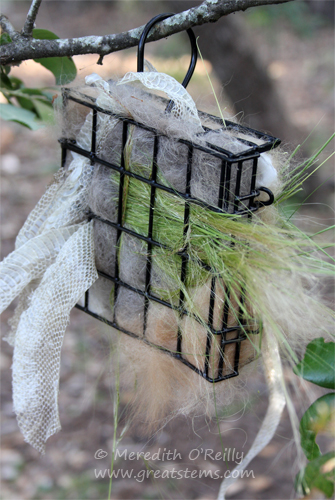
Snake skins? you might ask. Believe it or not, some birds decorate, so to speak, their nests with snake skins. It is believed that they do this to keep would-be predators away, especially mammalian predators. Birds that have been seen using snake skin include Titmice, Blue Grosbeak, and especially Great Crested Flycatcher. I imagine others do it, too, if not for predator avoidance then just because it makes a handy material.
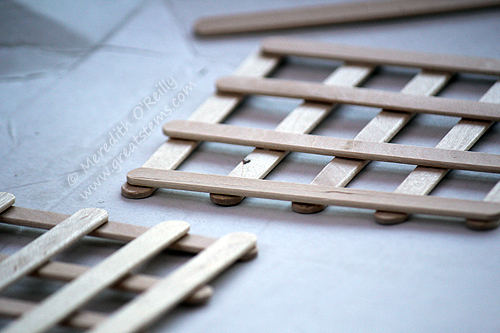
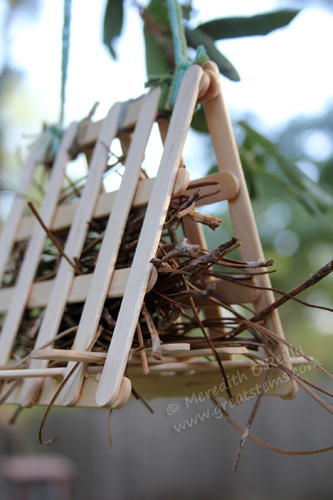
It’s easy to be creative with holders — the important thing is to have fun! Here are some ideas:
- Suet container
- Homemade box of twigs or craft sticks (use outdoor, non-toxic glue)
- Grapevine ball or wreath
- Small or medium-sized basket
- A bowl or saucer or small bucket
- Twine to make a loose ball
- Cardboard egg carton, with holes cut out
- Eggshells to make little people
- Strawberry basket
- Hollowed-out coconut shell
Whatever you choose, think about bird safety. Can birds land and fly away without getting trapped? For this reason, never use mesh bags — they can trap feet and legs or be a strangulation hazard.
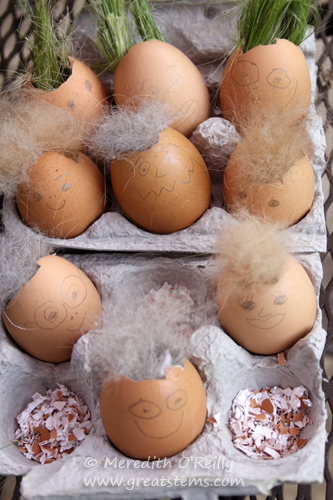 We had fun making eggshell “people.” Eggshell people are multi-purpose. Obviously they can serve as holders for different nesting materials, but the eggshells themselves can be beneficial as a calcium source for female birds, who need the mineral in order to lay eggs with strong shells, boosting the survival rate for their young. In the wild, birds might consume snail shells for calcium or even the discarded eggshells from their own nest.
We had fun making eggshell “people.” Eggshell people are multi-purpose. Obviously they can serve as holders for different nesting materials, but the eggshells themselves can be beneficial as a calcium source for female birds, who need the mineral in order to lay eggs with strong shells, boosting the survival rate for their young. In the wild, birds might consume snail shells for calcium or even the discarded eggshells from their own nest.
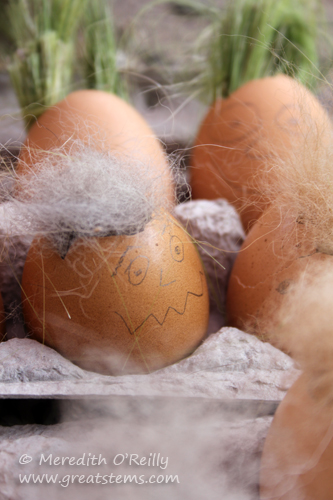 To make eggshell people, simply carefully crack eggs as you make breakfast one morning — create a small hole toward one end of each egg. Be sure to save the small broken pieces. Rinse the egg shells and broken pieces, then sterilize them by boiling them for 10 minutes, baking them at 250 degrees F for 20-30 minutes, or microwaving them for 2 or more minutes (with more eggs, lengthen the time). When the eggshells are cool and dry, fill them with dog fur, grass clippings, or other materials. To make a face, paint on fruit or beet juice, or just use a pencil to make a light drawing (FYI: today’s pencil “lead” doesn’t actually contain lead, but large quantities of the carbon-based graphite could irritate birds’ GI tracts (think parrots chewing on pencils); however, a minute amount isn’t a concern).
To make eggshell people, simply carefully crack eggs as you make breakfast one morning — create a small hole toward one end of each egg. Be sure to save the small broken pieces. Rinse the egg shells and broken pieces, then sterilize them by boiling them for 10 minutes, baking them at 250 degrees F for 20-30 minutes, or microwaving them for 2 or more minutes (with more eggs, lengthen the time). When the eggshells are cool and dry, fill them with dog fur, grass clippings, or other materials. To make a face, paint on fruit or beet juice, or just use a pencil to make a light drawing (FYI: today’s pencil “lead” doesn’t actually contain lead, but large quantities of the carbon-based graphite could irritate birds’ GI tracts (think parrots chewing on pencils); however, a minute amount isn’t a concern).
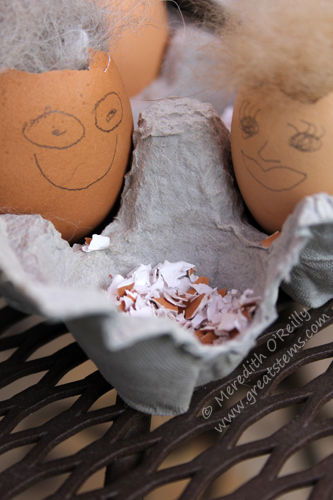
Crush the smaller broken pieces until they are seed size. Set them out in a small bowl or egg carton, or just sprinkle on the ground — possibly near a bird feeder if you have one. As birds remove materials from the eggshell people or if the shells get broken, just crush those up, too. Then compost the container. Voila!
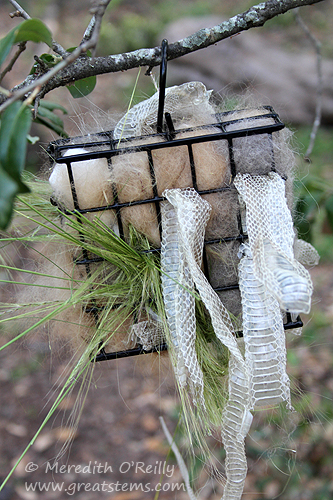
One extra tip — make sure a bird can easily pull the materials out of the holders. Sometimes suet feeders, for example, can clamp items in too tightly, especially if you overstuff them. Give materials a test pull!
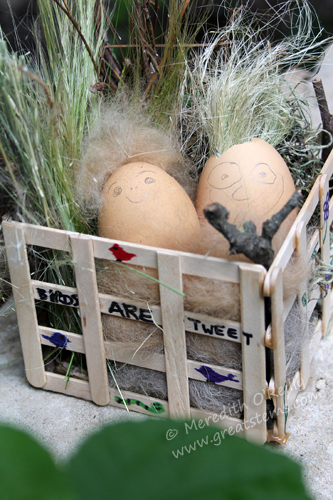 One final note — have fun!
One final note — have fun!
Interested in other nature/wildlife activities for kids? Visit this page!
Whaddya’ mean – “for kids”? I can’t wait to try some of these myself. Looks like a great rainy day project for all ages (if we only had some rain.)
You and me both, Vicki!
Pingback: Wildlife Projects for Kids: Making a Nature Journal | Great Stems
Pingback: Wildlife Projects for Kids: Milk Jug Bird Feeders | Great Stems